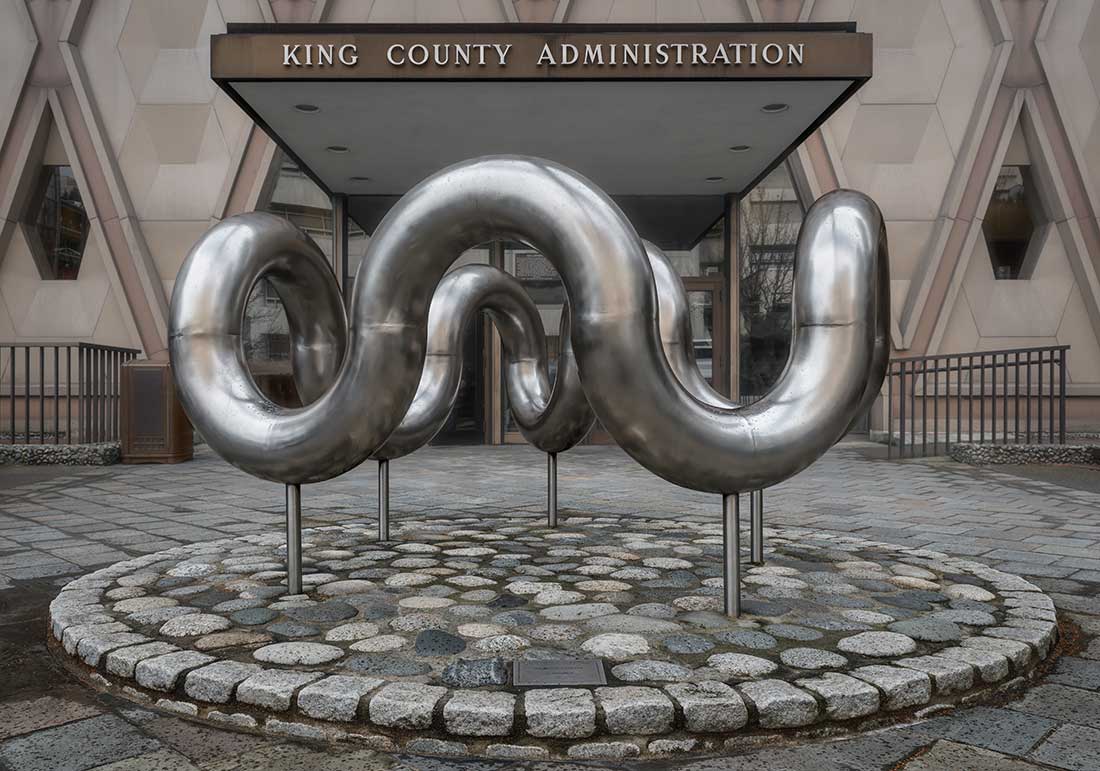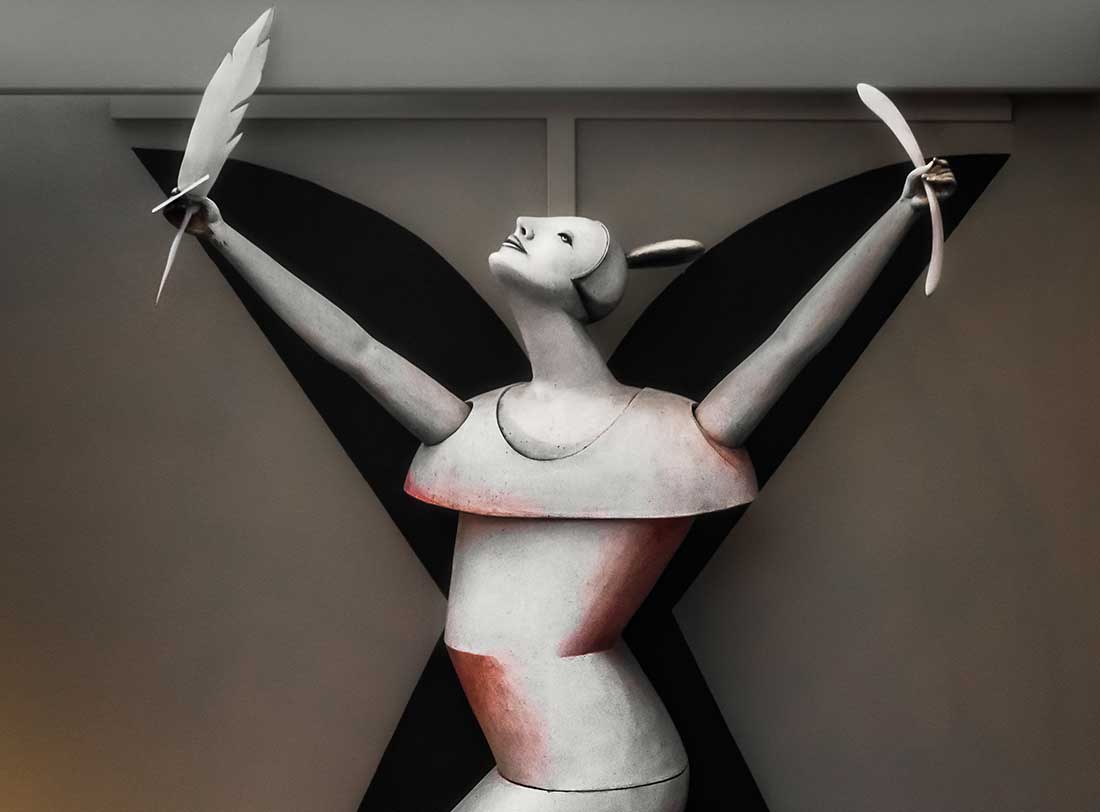A Special Collection Recognizes Sustained Excellence

Artworks by some of our region’s most renowned artists give meaning and character to public spaces all around the county. George Tsutakawa’s Sandworm, an undulating steel sculpture inspired by a burrowing marine animal, anchors the 5th Avenue entrance to the King County Administration Building. An abstract painting by William Ivey—once a student of Mark Rothko—exudes shades of blue in a district courtroom. The Palace of Darius by Mary Henry conveys feeling through meticulously distilled forms at the Maleng Regional Justice Center. Inside the Dexter Horton Building, the complex honeycomb of Cris Bruch’s Mantle appears to glow.
These exceptional works all belong to the Honors Program, a select group of pieces from the King County Public Art Collection acquired over the last five decades. The King County Arts Commission, now 4Culture, started the program in 1976 as a way to lift up the region’s established and mid-career artists and showcase their work in accessible settings. Today, this special collection includes dozens of pieces, offering windows into local interests and histories, and encompassing a variety of art movements as well as our enduring fascination with nature, mythology, geometry, and more.
In some cases, the works themselves have made history. For instance, Robert Sperry—an artist known for pushing the edges of possibility with ceramics—created his largest-ever work for the Honors Program over the course of two years; Untitled #635 is a feat of ingenuity with clay, made using the traditional Japanese kiln firing techniques and dark glazes that were Sperry’s signature. Nine Pentagons: Concave/Convex, an Honors Program commission by Robert Maki, belongs to a significant series of the artist’s metalworks and drawings that explores somatic and perceptual experiences of shape.
Just as much of local art history passes through the halls of the art department at the University of Washington, so did the artists behind many of the works in the Honors Program. Tsutakawa, Sperry, Patti Warashina, Jacob Lawrence, and Alden Mason—whose three-panel mural Lunar Promenade hangs at the King County Administration Building—all taught at UW for many years, leaving indelible impressions on their students, quite a few of whom went on to become accomplished artists in their own right. Beyond the university, Tsutakawa was also a member of the Northwest School, a group of area artists who rose to prominence in the mid-20th century. Oil painter Guy Anderson—one of four artists at the core of the school, along with Kenneth Callahan, Morris Graves, and Mark Tobey—also contributed an Honors piece: Sisyphus, which currently hangs at the Seattle Convention Center.
The first Honors Program artworks were initially acquired for the Kingdome, the erstwhile Seattle stadium that opened in 1976 and was home to the Seattle Seahawks, Mariners, SuperSonics, and Sounders. Games by Lawrence—one of the most renowned Black American painters of the 20th century—vividly depicts athletes and spectators in a large mural. Michael Spafford’s 70-foot-tall Tumbling Figures originally lined an external wall of a Kingdome elevator shaft, and a riot of color in Harold Balazs’ Rhododendrons brought life to the stadium. When the Kingdome was demolished in 2000, these works began journeys to new locations, carefully re-sited by 4Culture’s public art team. Today, you can find Games inside the Seattle Convention Center, Tumbling Figures on the façade of a downtown parking structure, and Rhododendrons outside the 4th Avenue entrance to the King County Administration Building.
“It was important to keep these remarkable artworks visible in places where people could experience them every day,” says Jordan Howland, 4Culture’s Senior Public Art Project Manager. “Though it’s not particularly common for us to move large, site-specific work like the pieces from the Kingdome, our team regularly rotates smaller portable works through county buildings. From re-siting to major maintenance and restoration, we do whatever is needed to make sure the art can be seen and appreciated.”

Sometimes the best way to keep an artwork accessible is to loan it to another organization with a public location—that’s how Games and Sisyphus landed at the Convention Center. In other circumstances, artists create work specifically to suit a particular location, like Warashina’s Mercurial Miss, a large sculpture depicting a female version of Mercury, the Roman God of commerce, which found its place in the lobby at Bellevue’s Meydenbauer Center. (Mercurial Miss was made in 1994; since then, Warashina’s career has continued to flourish. Her most recent public art piece is the human figure Dreamer, installed in 2022 at the corner of Seattle’s Westlake Avenue and Republican Street, and commissioned by Vulcan Real Estate.)
The Honors Program collection is still growing. When resources allow, 4Culture’s public art team assembles a panel of art professionals to review Honors nominations and recommend artists for consideration. Once selected, the artists either contribute an existing work to the collection or create something new—with the artwork’s scale, materials, and subject matter entirely up to them.
We’ve already profiled a dozen of the remarkable works in the Honors Program—not only sharing the inspirations and processes behind them, but also offering a glimpse into the importance of the artists themselves. Later this year, we’ll publish more stories about Honors pieces, including Dale Chihuly’s Puget Sound Forms, which you may have seen at the Seattle Aquarium, and works by Paul Horiuchi, Margaret Thompson, Boyer Gonzales, James Washington Jr., and Gaylen Hansen.
We hope you’ll visit these works in person when you have a chance. Until then, please enjoy learning more about the Honors Program and what makes theses artworks so valuable to our community.
